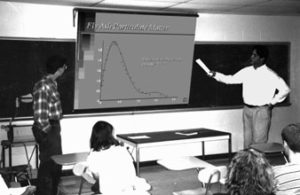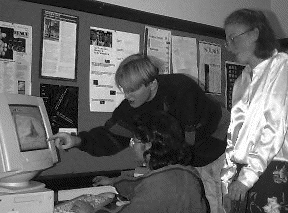
- Student Members of Research Team giving joint presentation at Miami University Symposium From left to right : Ben Perry and Brian Moyers
- Writing Final Reports
- Presentations to Kentucky Environmental Foundation
- Talks Given by Students at Mathematics Conferences
- Experiencing the Life of a Researcher
Each summer’s research team produced an extensive final report which included the methodology and results of the research. These reports were shared with the KEF, and a brief summary of the summer research2 was published by the KEF for the CG. The KEF has also requested permission to publish a complete report of the research and outcomes.
Writing these final reports required a significant amount of team-work to bring the individual research and perspectives together into a cohesive whole. The students had to recognize and fill in the other student’s knowledge gaps, so that each student could come to a general understanding and overview of the entire project. Both in their discussions with members of the KEF and in the written final report, the students encountered the difficulty of trying to explain the technical work they had done to a non-technical audience. In writing the final report, they discovered that writing down their findings was not as simple as it first appeared.

Student Members of Research Team at work Clockwise from top right : Whitney Blackburn, Srabasti Dutta, Eduardas Valaitis
The research students, Brian Moyers and Ben Perry, have given several joint addresses. The first of these was at the Fall Pi Mu Epsilon student conference at the University of Miami at Oxford. The audience for this presentation was mostly mathematically-oriented students and faculty, and the presentation was pitched at that level, demonstrating modeling assumptions, techniques, and results. Ben and Brian mastered the multimedia software package PowerPoint in order to give a more professional presentation and so were better able to focus on the graphical and numerical analyses of the research. Immediately following their presentation, the students were invited by another conference organizer to repeat their talk at another conference! Their second and third presentations were to local environmental groups. Their second talk was in early October at a local meeting of the Common Ground. The third was in Dr. Pearce’s Environmental Issues class. This talk was, in fact, by the request of the students in the class, not at the instigation of the instructor. These last two talks focused more on the results and their implications rather than on the methodology and mathematics.
The students of the summer research team have also given several presentations. In August, Srabasti Dutta, Whitney Blackburn, and Eduardas Valaitis presented the final results to the KEF. In September, Whitney and Eduardas gave an address at the Fall Pi Mu Epsilon student conference at the University of Miami at Oxford, and Srabasti gave a talk in Dr. Pearce’s environmental modeling class during December. The research students, Brian Moyers and Ben Perry, have given several joint addresses. The first of these was at the Fall Pi Mu Epsilon student conference at the University of Miami at Oxford. The audience for this presentation was mostly mathematically-oriented students and faculty, and the presentation was pitched at that level, demonstrating modeling assumptions, techniques, and results. Ben and Brian mastered the multimedia software package PowerPoint in order to give a more professional presentation and so were better able to focus on the graphical and numerical analyses of the research. Immediately following their presentation, the students were invited by another conference organizer to repeat their talk at another conference! Their second and third presentations were to local environmental groups. Their second talk was in early October at a local meeting of the Common Ground. The third was in Dr. Pearce’s Environmental Issues class. This talk was, in fact, by the request of the students in the class, not at the instigation of the instructor. These last two talks focused more on the results and their implications rather than on the methodology and mathematics.
Dr. Blackburn-Lynch was invited by Berea College to present a talk to the teaching faculty of the College on the pedagogical value of undergraduate research. He decided to invite student members of each of the research teams to join him. In January, he, along with Brian Moyers and Whitney Blackburn, presented “Undergraduate Research as a Teaching Tool.” The focus of the talk was on how undergraduate research can clarify career choices, can provide a capstone experience for a major while demonstrating the value of interdisciplinary work, and can provide a unique learning experience that supports the general education program goals. The depth of the self-reflection the students had developed in considering their own learning impressed the faculty audience and surprised even Dr. Blackburn-Lynch. One of the effects of the research experience as described by the students was upon their future graduate school plans. Though both students were Mathematics majors with essentially no background in environmental work prior to their research experience, they are both planning to go into such a field. Brian has recently been accepted to Johns Hopkins in Biostatistics, and Whitney has applied to several environmental engineering programs.
In a non-service learning environment, students do not typically provide services to anyone outside the working environment. Thus, students often do not have the satisfaction of seeing their work actually needed, desired, or used by anyone other than the instructor or principle investigator. During this research, students applied their knowledge to the creation of a real product, and they saw their work genuinely used by a group of people outside of the research team. In addition, they got to taste what the life of a professional researcher might be like. It has been the experience with this and past service-learning projects that students often create a more professional product because they have made a commitment to someone other than just the principle investigator. In addition, the increased motivation provides students with more focus and more reason to adhere to deadlines. In addition, Drs. Pearce and Blackburn-Lynch think such projects help students to synthesize and develop confidence in their abilities.